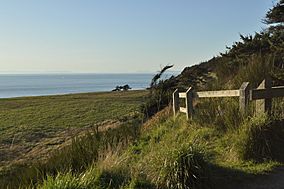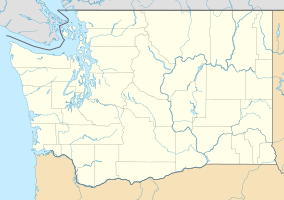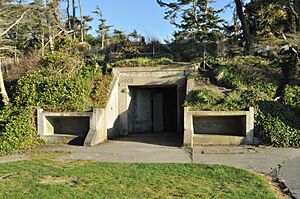Fort Ebey State Park facts for kids
Quick facts for kids Fort Ebey State Park |
|
|---|---|
 |
|
| Location | Island, Washington, United States |
| Area | 651 acres (263 ha) |
| Elevation | 16 ft (4.9 m) |
| Established | 1965 |
| Operator | Washington State Parks and Recreation Commission |
| Website | Fort Ebey State Park |
Fort Ebey State Park is a fun place for people to visit on the west side of Whidbey Island in Washington State. It's about 5 miles west of Coupeville in Island County. This park covers 651 acres and looks out over the Strait of Juan de Fuca. It's also part of the Ebey's Landing National Historical Reserve. The Washington State Parks and Recreation Commission takes care of the park.
Contents
What is Fort Ebey State Park?
Fort Ebey State Park is a large outdoor area where you can enjoy nature and learn about history. It was once a military fort built to protect the coast. Today, it's a popular spot for many outdoor activities.
Why was Fort Ebey built?
Fort Ebey was built in 1942 during World War II. Its main job was to protect the coast near the mouth of Puget Sound from enemy attacks. The fort was named after Isaac N. Ebey, an early settler on Whidbey Island. It had big guns, called 6-inch guns, which were later taken apart.
When did it become a park?
The state first bought land for the park from the government in 1965. More land was added between 1968 and 1974. Even more land was added in 1990 and 1997. The park officially opened to the public in 1981.
What can you do at Fort Ebey State Park?
Fort Ebey State Park offers many cool things to do outdoors.
Exploring the Shoreline and Trails
The park has 3 miles of saltwater shoreline where you can explore the beach. There's also a small freshwater lake called Lake Pondilla. If you love hiking, there are 25 miles of trails. A 4-mile part of the Pacific Northwest National Scenic Trail goes through the park.
Fun Activities for Visitors
You can enjoy many activities at the park, including:
- Having a picnic with your family and friends.
- Camping overnight under the stars.
- Fishing in the lake or along the shoreline.
- Searching for interesting shells and rocks on the beach (beachcombing).
- Watching or trying paragliding, which is like flying with a special parachute.



